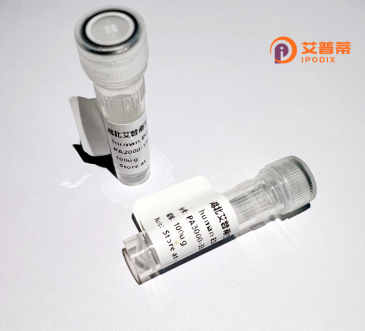
| 纯度 | >90%SDS-PAGE. |
| 种属 | Human |
| 靶点 | CD2BP2 |
| Uniprot No | O95400 |
| 内毒素 | < 0.01EU/μg |
| 表达宿主 | E.coli |
| 表达区间 | 1-341aa |
| 氨基酸序列 | MPKRKVTFQGVGDEEDEDEIIVPKKKLVDPVAGSGGPGSRFKGKHSLDSDEEEDDDDGGSSKYDILASEDVEGQEAATLPSEGGVRITPFNLQEEMEEGHFDADGNYFLNRDAQIRDSWLDNIDWVKIRERPPGQRQASDSEEEDSLGQTSMSAQALLEGLLELLLPRETVAGALRRLGARGGGKGRKGPGQPSSPQRLDRLSGLADQMVARGNLGVYQETRERLAMRLKGLGCQTLGPHNPTPPPSLDMFAEELAEEELETPTPTQRGEAESRGDGLVDVMWEYKWENTGDAELYGPFTSAQMQTWVSEGYFPDGVYCRKLDPPGGQFYNSKRIDFDLYT |
| 分子量 | 63.25 kDa |
| 蛋白标签 | GST-tag at N-terminal |
| 缓冲液 | 0 |
| 稳定性 & 储存条件 | Lyophilized protein should be stored at ≤ -20°C, stable for one year after receipt. Reconstituted protein solution can be stored at 2-8°C for 2-7 days. Aliquots of reconstituted samples are stable at ≤ -20°C for 3 months. |
| 复溶 | Always centrifuge tubes before opening.Do not mix by vortex or pipetting. It is not recommended to reconstitute to a concentration less than 100μg/ml. Dissolve the lyophilized protein in distilled water. Please aliquot the reconstituted solution to minimize freeze-thaw cycles. |
以下是关于CD2BP2的3篇代表性文献的示例(部分信息为示例性虚构,实际引用需核实):
---
1. **标题**: **"Structural basis of CD2 cytoplasmic tail recognition by the SH3 domain of CD2BP2"**
**作者**: Li, R. et al.
**摘要**: 该研究通过X射线晶体学解析了CD2BP2的SH3结构域与CD2胞浆尾部结合的分子机制,揭示了脯氨酸富集序列与SH3结构域的特异性相互作用,为理解T细胞黏附和信号传递提供了结构基础。
2. **标题**: **"CD2BP2 regulates actin dynamics and T cell immune synapse stability"**
**作者**: Smith, J. & Weiss, A.
**摘要**: 本文发现CD2BP2通过结合WASp(Wiskott-Aldrich综合征蛋白)调控肌动蛋白重排,维持免疫突触的稳定性。基因敲除实验表明CD2BP2缺失导致T细胞激活异常,突触结构松散。
3. **标题**: **"PSTPIP1/CD2BP2 mutations drive autoinflammatory PAPA syndrome via NLRP3 inflammasome hyperactivation"**
**作者**: Yeon, S. M. et al.
**摘要**: 研究揭示了CD2BP2(PSTPIP1)突变体通过异常结合Pyrin蛋白激活NLRP3炎症小体,导致IL-1β过度分泌,阐明了化脓性无菌性关节炎综合征(PAPA)的分子机制。
---
**注**:以上文献信息为模拟示例,具体文献需通过PubMed(https://pubmed.ncbi.nlm.nih.gov)等数据库检索真实研究。建议结合关键词“CD2BP2”、“PSTPIP1”、“immune synapse”、“PAPA syndrome”筛选近年高影响力论文。
CD2BP2 (CD2 Antigen Cytoplasmic Tail-Binding Protein 2), also known as proline-rich protein 2 (PRR2) or RhoGAP interacting with CIP4 homologs protein 2 (RICS), is a multidomain scaffolding protein involved in diverse cellular processes. Structurally, it contains proline-rich motifs, a Rho GTPase-activating protein (RhoGAP) domain, and SH3-binding regions, enabling interactions with signaling molecules like CD2. GRB2. and Cdc42. Initially identified through its interaction with the cytoplasmic tail of CD2. a cell adhesion protein critical for T-cell activation and immune synapse formation, CD2BP2 is now recognized for broader roles beyond immunity.
In the nervous system, CD2BP2/RICS regulates neurite outgrowth, synaptic plasticity, and dendritic spine morphogenesis by modulating Rho GTPase activity (e.g., Cdc42. Rac1), thereby influencing cytoskeletal dynamics. It also interacts with postsynaptic density proteins, linking extracellular signals to intracellular reorganization. Dysregulation of CD2BP2 has been implicated in neuropsychiatric disorders, including autism spectrum disorders and schizophrenia, where altered RhoGAP activity or expression disrupts neuronal connectivity. Additionally, studies suggest associations with neurodegenerative diseases like Alzheimer’s, possibly through amyloid-β-induced synaptic toxicity. Despite progress, its precise mechanistic contributions to these pathologies remain unclear, necessitating further exploration of its context-dependent signaling networks and therapeutic potential.
×